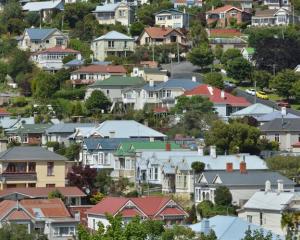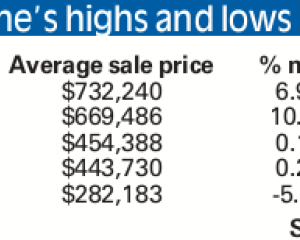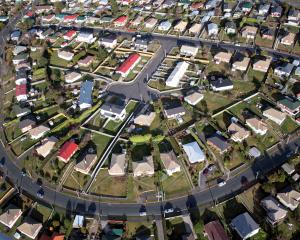
Cold, damp houses have been linked to everything from asthma to depression. Yet many of us will spend this winter in them, perhaps wondering how - with rising petrol and food costs - we will ever afford improvements. Kim Dungey looks at a significant problem and what the Government is doing about it.
Last winter Lesley huddled on her couch, buried in blankets and nursing a hottie.
She wore several layers of clothing, including two pairs of socks.
But her bid to keep cosy made little difference.
On the coldest mornings, frost formed on the inside of her windows and she could see her breath indoors. The chill made her bones ache. There were problems with condensation, too.
"It was awful. Just coming home to it was really depressing," says the St Kilda resident, who does not want her surname used.
Lesley was living not in a draughty old villa but in a reasonably modern townhouse. Built in the early 1970s, it had no insulation in the walls or under the floor and barely any in the ceiling.
A damp, mouldy smell lingered, even though she kept the property well ventilated.
"I kept thinking it was because it had been closed up," she says. "Nobody had been living in it for a while before I bought it. So when it wasn't cold, I opened all the windows but it kept coming back."
Lesley's situation has improved recently thanks to insulation paid for partly by the Government - more on that later.
But leading researchers, while applauding the government scheme, say the plight the Dunedin woman found herself in is common and we need to do better.
The Energy Efficiency and Conservation Authority (EECA) estimates about 750,000 New Zealand houses have inadequate insulation.
Winter indoor temperatures often fall well below World Health Organisation recommendations of 20degC in living areas and 18degC elsewhere, increasing the risk of respiratory illness, strokes and heart attacks.
And surprisingly, a New Zealander has more chance of dying from the cold than someone in the icy climes of Siberia or Scandinavia.
Prof Philippa Howden-Chapman, director of He Kainga Oranga, the housing and health research programme at the University of Otago (Wellington), says New Zealand's excess winter mortality figures are among the highest in the world and our underinsulated, underheated houses are partly to blame.
Studies show hospital admissions are 8% higher in winter than in summer. And about 1600 more people die - four times the road toll - mostly from circulatory illnesses, respiratory illnesses and infectious diseases.
"If our houses protected us better, you would barely see a seasonal effect."
Viruses survive longer in cold, damp houses, she explains. And in winter people tend to cluster in the one room that is heated, increasing their chance of passing on bacterial infections.
One of her community trials is asking older people whether they shiver inside their homes, an indication of the body trying to cope with low temperatures that is virtually unheard of in other developed countries.
"We also did a study with medical students, who you'd expect to be very healthy and found that students who judged their flats to be cold and damp were more likely to have illnesses during winter and time off from their studies."
Associate Prof Bob Lloyd, director of energy studies in the University of Otago physics department, says researchers calling on student flats in Dunedin have found occupants "jumping to the door" in sleeping bags and indoor winter temperatures as low as 2 or 3degC - colder than inside a refrigerator.
Prof Lloyd also calculated the percentage of New Zealand households likely to be in fuel poverty - a term used when they would need to spend more than 10% of their income on energy to provide a healthy indoor environment.
In 2001, the proportion was about 14% but by 2008, with electricity prices rising faster than incomes, it averaged 25% across the main centres and was 47% in Dunedin.
"[One] problem, especially in places like Dunedin, is that growth has been quite low, so the percentage of old houses is very high," he says. "Some have ceiling insulation which has been retrofitted but very, very few have wall insulation, double glazing or even underfloor insulation."
Insulation became mandatory in new houses only in 1978.
Providing ceiling insulation, underfloor insulation and efficient heating was sufficient in most of the North Island. But in the South this warmed some homes by less than half a degree and people would still be cold, even if they spent 10% of their income on heating. Other measures, such as double glazing and wall insulation, were also needed.
Compared to other work, retrofitting wall insulation is more difficult to do and more costly - about $10,000 to $15,000 for a 100sq m home.
For new homes, the current standard specifies both wall insulation and double glazing and the Government clearly thinks they are necessary for adequate housing, Prof Lloyd says. While the extra work in new houses is obviously at the expense of the owner, the issue is, who pays for such upgrades in existing homes?
It's important to note that while "fuel poverty" is based on what people should be paying, New Zealanders actually spend only a third of what they should to heat their homes, he adds.
In fact, the average household energy use in New Zealand has been constant at close to 8 megawatt hours per annum since 1974, despite people owning more appliances.
"The only explanation can be that as energy prices have gone up, people have reduced their energy use."
Matt Thomson, of EnergySmart, finds it easy to illustrate the advantages of the Government's insulation and heating scheme.
One beneficiary was an elderly Dunedin widow, who he called on in winter, he says.
"She was wrapped in a blanket, the house was sitting at about 5degC and she was too scared to put a heater on because of the power bill."
After having subsidised insulation and a discounted heater installed, the woman told him her "whole life" had changed and she no longer suffered so badly with arthritis.
EnergySmart does work in about 500 Dunedin homes a year under the Warm Up New Zealand: Heat Smart programme and another 140 under Healthy Homes, a heavily subsidised project that is funded by government and community groups and targets the most in need.
The first scheme gives community services card-holders a 60% subsidy while the second costs homeowners only $500.
Thomson would like to see those who do not have community services cards able to spread the cost by adding it to their rates bill, and that may happen. After talking to a Nelson group which helps people into solar water heating, the Dunedin City Council is thinking about allowing people to use the lower interest loans it can secure to install solar water heating, insulation and double glazing.
Under the proposal, people would repay the money via a targeted rate attached to their properties.
Six other councils also allow ratepayers to pay off home insulation and heating through their rates bills, EECA says.
The Warm Up New Zealand programme it administers has provided funding for one-fifth to one-quarter of all houses in need.
The Government is investing $347 million over four years to retrofit at least 188,500 homes with insulation and clean heating. The subsidies are funded until the end of June 2013.
The authority says 94,600 houses were retrofitted in the 21 months to the end of March this year (the number has since passed 100,000), and of these, 4500 were in Otago.
The work cost $288 million but is expected to save $590 million in avoided health costs and $455 million in avoided energy use and carbon emissions over the next 20 years - a return of about $3.60 for every dollar invested.
University of Otago researchers estimate that by the end of the programme, there could be up to 33% fewer hospital admissions for people with pre-existing respiratory conditions.
Across all houses, the average temperature is modelled to increase 1.3degC, from 17.7degC before retrofitting to 19degC after. The scheme is based on building code standards and requires a higher level of ceiling insulation in climate zone 3 (the South Island and North Island central plateau).
The average cost of installing ceiling and underfloor insulation in an uninsulated house is $3700, EECA says. But the actual cost of retrofits is more like $2700 because many houses already have some insulation or because insulation can not be put in inaccessible ceiling and floor spaces.
About 88% of homeowners have used the subsidies for insulation, while the rest installed heaters.
While many people simply can't afford to insulate - subsidy or not - others don't see it as a priority.
Beacon Pathway, which aims to make homes cheaper to run and healthier to live in, says many homeowners are more concerned with improving the look or the size of their houses than their performance or the impact they have on their health.
The group surveyed three sets of owners - high energy users, recent movers and landlords - and found all of them were resistant to spending money on retrofitting for energy savings.
"When we buy motor cars, we look for a whole lot of features around comfort, safety, speed, economy and aesthetics," says general manager Nick Collins. "But when we buy houses, we buy on location and aesthetics. I'm sure most people never ask the question, how is the house likely to perform?"
Home renovators are confused about products on the market and often spend money on gadgets and aesthetics rather than basics like insulation and energy-efficient heating, he adds. However, once given independent, factual information and a plan tailored to their property, their preferences change.
Collins says the Warm Up New Zealand programme has helped make people aware of the need for insulation and heating, and provided subsidies for all New Zealanders.
The problem is up to 800,000 houses still need to be insulated and the capital required is "enormous".
"If you were to take a package that Beacon advocates, it's about $20,000 [per house]. If you were to take just insulation and heating, it's $5000 to $7000."
"How do you do it? I suppose it's one bite at a time," he says, adding that cold damp houses lead to poor health, absenteeism from work and reduced productivity.
"What we have to do is accelerate the pace of upgrading our homes, while at the same time paying for those health incidents."
But people like Collins may also be battling the Kiwi psyche that suggests we should simply man up when it gets cold and put on another layer of clothing.
That's not so much of a problem if you are young and healthy, Prof Howden-Chapman says. But if you're a baby (whose temperature regulation is less efficient), an older person with compromised health or someone with a chronic illness, putting on a jersey to protect you from a cold, damp house leaves your health at risk.
"We need to take the issue much more seriously and really look at the costs and benefits of improving our housing stock and say it's not good enough to leave existing houses to have no standards at all."
Putting on jumpers and heating just single rooms also causes deterioration of the building fabric, Prof Bob Lloyd says.
"Cold houses which are heated for short periods of time have large amounts of condensation so you get mould growth. That rots timber and causes health problems."
A "legacy of light regulation" in housing and energy is driving fuel poverty, Prof Howden-Chapman says.
The building code for new houses is not particularly rigorous compared to European standards and there is no regulation for existing houses, including rentals.
"Landlords are not required to have their property insulated and you're not required to insulate your house at point of sale, which are two obvious ways in which you could exercise leverage."
"And in energy - despite the fact several of the energy companies are owned by the Government - there's no regulatory requirement, as there is in Britain, to require companies to have special rates for low-income people."
The Office of the Gas and Electricity Markets (Ofgem), which regulates the electricity and gas markets in Britain, is required to take account of the needs of vulnerable customers, particularly older people, those with disabilities and those on low incomes.
The Government also aims to eliminate fuel poverty as far as reasonably practicable among households in England, Scotland and Northern Ireland by 2016 and in Wales by 2018.
Here, only 15% of the retrofits completed so far have been of rental properties.
"Landlords are extremely reluctant to spend what they consider good money to help their tenants keep warm and the only way to solve that problem is to legislate for it," Prof Lloyd says. "Voluntary methods just don't work."
In England, green campaigning charity Friends of the Earth is calling for a law that would make it illegal for landlords to re-let the coldest properties until they are improved to a basic standard of energy efficiency. The group says almost 656,000 rented homes in England are so cold they are officially a health hazard and caring for people made ill living in them costs the NHS 145 million ($NZ290 million) a year.
While England has historically had poor housing compared to its cooler northern neighbours, even there double glazing and central heating have long been the norm.
So when sustainable architecture expert Robert Vale emigrated from England in 1996, he was surprised to find that New Zealanders typically had single glazing, little insulation and heated only one room, usually with an open fire or a wood-burner.
And Vale, a professorial research fellow in the School of Architecture at Victoria University, says things have got worse, not better, because houses are now much bigger.
"Instead of having small inefficient houses, people now have big inefficient houses," he says, adding that even our so-called energy-efficient homes lag 30 years behind those in Europe.
While it is good that the second-biggest source of home heating in New Zealand is wood, the percentage of renewable forms of energy in New Zealand's overall energy mix is declining.
"There's a big focus on finding more oil and gas and using coal, which is quite archaic compared to policy in many places."
"The big move towards heatpumps is also potentially going to increase the demand for electricity, especially where heatpumps are replacing wood heating, and that won't be so good."
In England, required R-values (the capacity of an insulating material to impede heat flow) were "not very impressive" until the 1980s and '90s. However, things have improved to the point where the UK now plans for all new homes to be zero carbon emission from 2016.
Campaigners there say more than a quarter of the UK's carbon emissions come from homes and stopping them leaking heat would be one of the cheapest and quickest ways to fight climate change.
New Zealanders, however, look for thermal improvements to give a payback in five or so years, Vale says.
"The average New Zealand house has an economic life of about 100 years, so all the houses we build today will still exist at a time when there is no oil, no gas and very little coal.
Saying that [improving a home's thermal performance] is not cost-effective is silly because it's taking a very short-term view of a very long-term product."
Residential electricity prices have increased by 81% in the past 10 years - substantially faster than average inflation - so those whose benefits and salaries are linked to the CPI have found it harder to pay for electricity, Prof Howden-Chapman says.
And there is "nothing" to stop energy prices continuing to rise as we pass peak oil - the point at which global production of oil reaches its maximum rate, after which it will decline.
"This is going to be a growing problem unless it's seen as a policy issue and something is done about it."
Prof Lloyd also believes there is some urgency. Peak oil and climate change are likely to disrupt the world economy and make it more difficult to afford such upgrades, he says.
Bringing houses close to the standard for new ones will require "intervention" from central and local government. This could take the form of funding, loans, legislation for rental properties, tax breaks, or bulk buying of insulation material as per pharmaceuticals.
He is also in favour of taxing polluters to fix up their "environmental problems and extravagant resource usage".
While an emissions trading scheme could potentially create revenue for home insulation, the present scheme is "pretty much a failure and a transfer of taxpayers' money to the polluters".
His advice for Otago people this winter? Install a heatpump, or - if it is allowed in your area - a wood burner. Pressure your landlord to fit insulation in the ceiling and, if you own your home, take advantage of government subsidies while they are still available, to insulate your ceiling and floor.
"Although it's not sufficient, it's still a start and every bit helps."
Lesley, the Dunedin woman referred to earlier, was almost in tears after receiving quotes of up to $6000 to insulate the ceiling and floor of her home. As a community services card-holder, she could not afford such charges and faced another winter of constant colds and aching bones.
Then she called Energysmart, who told her she was eligible for the Healthy Homes scheme and would have to pay only $500.
She has noticed already that her newly insulated home is warmer and the damp smell has disappeared.
In her opinion, New Zealand houses are not built for local conditions.
Waikouaiti retirees Margaret and Lindsay Hamilton have a similar story to tell.
Their 1960s brick house had only a small amount of fibreglass insulation under the floor and never really felt warm despite them using a woodburner and a heatpump.
Last winter, the cold started to bother them and they decided to do something about it. Mrs Hamilton knew they might qualify for a discounted heater but was not aware of the other government subsidies and thinks they should be publicised more widely.
Having had their home insulated, she and her husband are looking forward to lower power bills and cannot believe they lived in a house that was as cold as it was.
"It was terrible, thinking back. Shocking."
So much for New Zealanders suggesting people "toughen up and put on another jersey", Mrs Hamilton says.
"I think that's so stupid when you could be lovely and warm."
HEAT LOSS
• A typical New Zealand home without insulation loses 30% to 50% of its heat through the roof, 18% to 24% through the walls, 21% to 31% through the windows, 12% to 14% through the floor and 5% to 9% through air leakage.
• Insulate your ceiling first, then under the floor. Walls and windows are both relatively difficult and expensive to insulate in an existing house and are usually left until you are renovating. Install wall insulation if you need to remove wall linings and put in double glazing when replacing windows.
• The minimum recommended R-values for existing homes in the South Island are R1.4 bulk insulation under the floor and, in ceilings, an R3.2 blanket or R4.0 segment insulation where there is 0mm-75mm of existing insulation, or R2.4 blanket insulation where there is 75mm-120mm of existing insulation. It's good to install more if you can.









